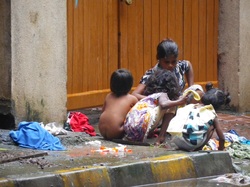 Pavement dwellers, Mumbai 2013. Pavement dwellers, Mumbai 2013.
Before I began my summer vacation, I marked diploma exams. Of the 300 or so papers I marked, only one of them mentioned India. And I realized we don’t really teach about India even though it’s a vital nation to look at, especially in terms of ideology, freedom and equality. You may have heard of India –the world’s largest democracy-as poster child for the liberalization of trade. It has had impressive growth rates over the last decades as it moved away from a socialist economy. I thought of it as a bit of a miracle myself until this summer when I travelled there for a month. I’m not an expert on the country, but it was a mindboggling trip that made me stop and think. Culturally and linguistically more diverse than the entire continent of Africa, India is faced with enormous challenges. Although the food is fabulous and although India ranks second in the world for agricultural output, 55% of India’s children suffer from malnutrition. It is home to one third of the world’s poor. What does “poor” mean? The government defines extreme poverty (experienced by 138 million of its citizens) as living on 44 Canadian cents a day. We know that no one in Canada could survive on that little money. Although things are definitely cheaper in India, even the cheapest meal costs 31 cents. There is a lot of debate about what poverty really means. Economists say they have to keep that definition low, because if the definition was changed, the government would have to provide subsidies to 2/3 of the entire population. There is a great deal of disparity in India. Slums beside elegant apartment complexes; luxury SUVs drive alongside rickshaws; pavement dwellers live on sidewalks just meters away from upscale hotels. In his novel Shantaram Gregory David Roberts talks about the great freedom of India, suggesting that it’s great that the poor are free to live right beside the rich. But to my mind, if the rich see the poor living right beside them, wouldn’t they want to do something about it? That doesn’t seem to be the case as income disparity has doubled over the past 20 years. Everywhere I went I saw men. Men lined up at security checkpoints. Men in museums. Men working in stores and hotels and farms. But women? Not so many. Although female infanticide and gender-selective abortion are illegal, there are presently 37 million more men than women in India. Most of these girls are aborted before birth; others are mistreated and malnourished to the point that in the 0-6 age group, there are 7 million fewer girls than boys. Look at the website 50 million missing, founded by activist Rita Banerji, who graciously donated some of her photos for use in this course. India is a beautiful country filled with spectacular natural beauty and fabulous buildings. Its people are warm and friendly. It’s an amazing place to visit. It’s even more interesting look at from the perspective of liberalism. In the case of freedom and equality, India shows they do not always go hand in hand.
The inherent vice of capitalism is the unequal sharing of blessings; the inherent virtue of socialism is the equal sharing of miseries.
Winston Churchill
The video below graphically demonstrates the growing inequality in the United States. While Canada does not have this degree of income inequality, it is moving in that direction. Under our current economic system, we see a greater and greater divide, not between the rich and the poor, but between the extremely wealthy and everyone else.
Are the extremely wealthy in their position because they are more clever with their money, they want wealth more, or somehow deserve to be richer than everyone else? Or is it because they work so much harder? 380 times harder?
Is income inequality the inevitable outcome of capitalism? What about the idea of trickle down economics, or Adam Smith's theory of the invisible hand?
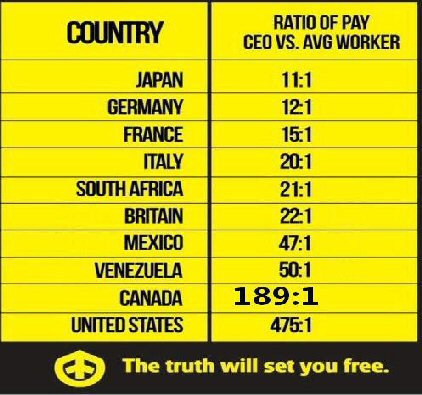
http://www.canadiansocialresearch.net/images/ceo_income.jpg
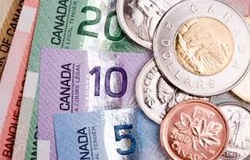 What do Canada and Germany have in common? Besides winter, a love of beer, and parliament buildings, what does Canada have in common with Germany? A Triple-A credit rating, that’s what! A credit rating is an estimate of your ability to pay back your debts. Credit ratings are given to individuals when they apply for loans, and they are also given to nations by credit rating agencies to show how reliable they will be in paying off their debts, based on their previous actions. The highest credit rating available is a Triple A rating. On February 22, the United Kingdom had its credit rating downgraded. The United States and France have both had their rating downgraded recently, leaving Canada and Germany as the only two remaining western nations with a Triple A rating. What does that really mean? A credit rating is an indication of financial health and prospects for the future. Having a high credit rating means that more people will be likely to invest in your nation as it's seen as a safe bet. Credit rating agencies don’t like debt. They like to see governments making an effort to curb their spending and increase their earning of income. What would it mean for an economic system to be completely free? Would there be credit ratings? Would there be controls on debts and investments? The economies of Canada and Germany survived the economic crisis of 2008 better than many nations, partly due to their more regulated economies. Canada is apparently doing pretty wel, although some reporters feel our days are numbered. If our economic growth continues to slow down, we could be the next nation to lose that favoured status.
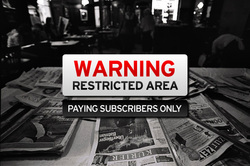 Freedom of speech is essential in a liberal democracy, and indeed an informed citizenry is critical to the functioning of a democracy. But is information in countries like Canada free? Or is it controlled by publishers for their own profit? The recent suicide of internet activist Aaron Schwartz has brought the Open Access movement back into the news, but as this recent article in al-jazeera points out, freedom of access to scholarly articles is about more than just being able to read a news article or a paper published by an academic researcher free of charge. It can be a life and death issue for people in less free nations. The article describes how the government of Uzbekistan created a fictional terrorist group in order to justify the shooting of civilian protesters. Yet the first article published about the event was posted behind an academic firewall- that is, posted in a journal that only people affiliated with a university could access. Scholars receive no money for these articles- the only profit goes to the website publishers. So the article was also published in an open access journal where it has since been used to help obtain freedom for political refugees.
Aaron Schwartz downloaded articles from JSTOR, an academic digital archives at MIT, because he believed information should be free. Before he committed suicide, he faced 4 million dollars worth of lawsuits and 30 years in jail .
Yes, it costs money to produce websites such as JSTOR. But who owns information? If knowledge is power, who should control it? What is the price of freedom?
 The 83 year old Ambassador Bridge between Windsor Ontario and Detroit Michigan is the busiest bridge in North America, accounting for 25% of the traffic in trade between Canada and the United States. It’s owned by an 85 year old American billionaire named Matty Moroun who makes $80 million a year off tolls and selling duty free gas and goods and even more from the sale of gas at the border, and his fleet of trucks that use the bridge to transport automotive parts back and forth across the bridge. The Canadian government wants to replace the bridge with a new one, which it will pay for. If you lived in Michigan, wouldn't you think that was a good idea? Economists call it an "amazingly sweet deal" for the people of Michigan. Moroun, however, is lobbying heavily for the people of Michigan to vote against the bridge . “Nothing is free” they are being told. Despite the fact that the Canadian taxpayers will foot the bill, the message is that “Someday, your grandchildren will be on the hook to pay for that bridge.” As a lobbyist, Maroun is using his extensive finances to back his campaign to continue to have a monopoly over bridge traffic.
At the heart of the Ambassador Bridge story is ideology. What best serves the common good? Tax-payer funded infrastructure that everyone pays for and everyone gets to use? Or privately owned services from which a handful of people profit? And how do we balance the common good with economic freedom? Should an individual have the freedom to benefit from control of an essential service ?
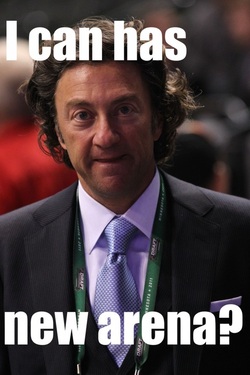 Today the Toronto Globe and Mail reported that Edmonton billionaire Daryl Katz donated nearly half a million dollars to the Alberta Progressive Conservative party prior to the last provincial election. This represents nearly a third of spending for the entire campaign. While election spending rules in Alberta state that no one can donate more than $30,000 to a political party, Katz’s cheque for $430,000 was split into several smaller donations. Katz, owner of the Rexall chain of pharmacies and the Edmonton Oilers is worth an estimated 3 billion dollars. He has recently been in the news over the proposed new arena in Edmonton, to which the province has committed $100 million dollars. Katz has demanded further concessions from the City of Edmonton which could also come from provincial funds for infrastructure. Has Katz’s financial donation to the Conservative party influenced their decision to subsidize the arena? The province says no. Does Katz really need money for the arena, based on his assertion that Edmonton is a small market that can’t afford a fancy facility? The numbers say no. (OK- that isn’t really relevant but makes for some good reading!) Meanwhile the whole topic of campaign spending is big in the United States, where “super PACs” (political action committees that receive or spend more than $1000) work hard to influence the outcome of an election. In the U.S. an individual may donate $2,500 to a candidate, $30,800 to a party and $5,000 to a PAC. The PAC has no limits to spending. In the run up to the 2006 presidential election in the United States to date , 189 super PACs have spent nearly half a billion dollars to promote their agenda- or to denounce the opposition. Federally in Canada, an individual can donate no more than $1,100 to a candidate or political party. Corporations, trade unions, and unincorporated organizations may NOT donate to a political campaign. ( Elections Canada) Most liberal democracies are based on the idea of “one person one vote”, and in theory they give power to the people- not just those with deep pockets. Do unlimited donations lead to corruption? What about economic freedom? Shouldn't you have the right to spend your money to influence others to vote a certain way? Is it possible that massive campaign spending strikes at the very essence of democracy Should there be limits to the amount someone can donate to a political party?
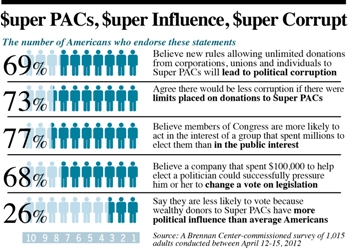
http://www.brennancenter.org/content/election2012
|
 Pavement dwellers, Mumbai 2013.
Pavement dwellers, Mumbai 2013. 






 RSS Feed
RSS Feed